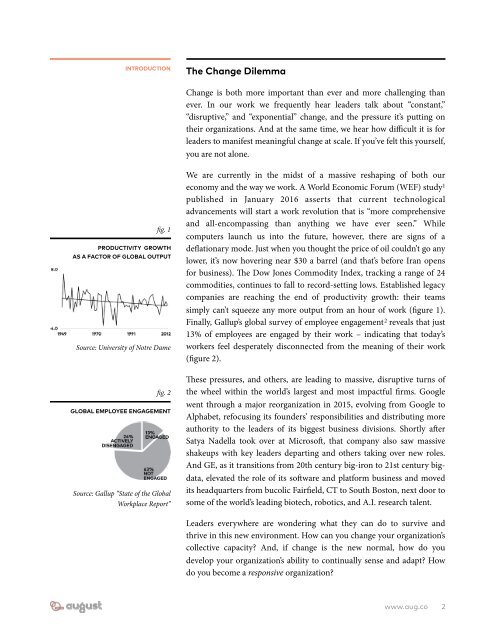FRONTIER Responsive Leadership
1Ux1Fd4
1Ux1Fd4
Create successful ePaper yourself
Turn your PDF publications into a flip-book with our unique Google optimized e-Paper software.
INTRODUCTION<br />
The Change Dilemma<br />
Change is both more important than ever and more challenging than<br />
ever. In our work we frequently hear leaders talk about “constant,”<br />
“disruptive,” and “exponential” change, and the pressure it’s putting on<br />
their organizations. And at the same time, we hear how difficult it is for<br />
leaders to manifest meaningful change at scale. If you’ve felt this yourself,<br />
you are not alone.<br />
fig. 1<br />
PRODUCTIVITY GROWTH<br />
AS A FACTOR OF GLOBAL OUTPUT<br />
Source: University of Notre Dame<br />
fig. 2<br />
GLOBAL EMPLOYEE ENGAGEMENT<br />
Source: Gallup “State of the Global<br />
Workplace Report”<br />
We are currently in the midst of a massive reshaping of both our<br />
economy and the way we work. A World Economic Forum (WEF) study<br />
1<br />
published in January 2016 asserts that current technological<br />
advancements will start a work revolution that is “more comprehensive<br />
and all-encompassing than anything we have ever seen.” While<br />
computers launch us into the future, however, there are signs of a<br />
deflationary mode. Just when you thought the price of oil couldn’t go any<br />
lower, it’s now hovering near $30 a barrel (and that’s before Iran opens<br />
for business). The Dow Jones Commodity Index, tracking a range of 24<br />
commodities, continues to fall to record-setting lows. Established legacy<br />
companies are reaching the end of productivity growth: their teams<br />
simply can’t squeeze any more output from an hour of work (figure 1).<br />
Finally, Gallup’s global survey of employee engagement<br />
2<br />
reveals that just<br />
13% of employees are engaged by their work – indicating that today’s<br />
workers feel desperately disconnected from the meaning of their work<br />
(figure 2).<br />
These pressures, and others, are leading to massive, disruptive turns of<br />
the wheel within the world’s largest and most impactful firms. Google<br />
went through a major reorganization in 2015, evolving from Google to<br />
Alphabet, refocusing its founders’ responsibilities and distributing more<br />
authority to the leaders of its biggest business divisions. Shortly after<br />
Satya Nadella took over at Microsoft, that company also saw massive<br />
shakeups with key leaders departing and others taking over new roles.<br />
And GE, as it transitions from 20th century big-iron to 21st century bigdata,<br />
elevated the role of its software and platform business and moved<br />
its headquarters from bucolic Fairfield, CT to South Boston, next door to<br />
some of the world’s leading biotech, robotics, and A.I. research talent.<br />
Leaders everywhere are wondering what they can do to survive and<br />
thrive in this new environment. How can you change your organization’s<br />
collective capacity? And, if change is the new normal, how do you<br />
develop your organization’s ability to continually sense and adapt? How<br />
do you become a responsive organization?<br />
www.aug.co 2



